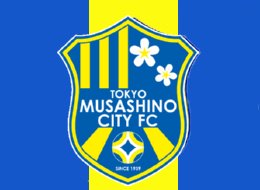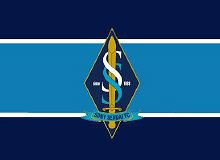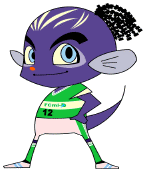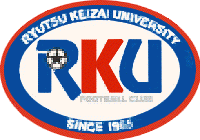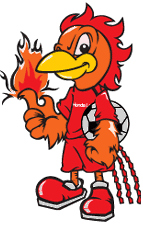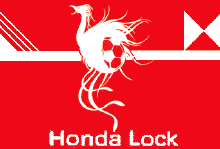- Details
- Hits: 4510
Tokyo Musashino City FC
|
Musashino City FC was originally established in 1939 as the club team of Yokogawa Electric, making it one of the oldest clubs in Japan. Based in Musashino City, in the western suburbs of Tokyo, Yokogawa entered the Kanto League during the 1970s with the formation of the Japan Soccer League. The team was quite competitive in the early years of the JSL, but following the formation of the J.League, Yokogawa Electric maintained a "company team" structure, and stayed in the amateur ranks, setting itself the goal of becoming one of the top amateur teams in the country. Since then, the team has gone through several incarnations, changing its name to Yokogawa FC and then to Yokogawa Musashino FC.
By the mid-90s, Yokogawa had become one of the strongest teams in the Kanto region, playing at the Regional level and winning the Kanto League title in both 1997 and 1998. With the formation of a J.League second division in 1999, Yokogawa FC became one of the most competitive clubs still in the amateur ranks, and was promoted to the newly reorganized JFL for the 1999 season. During the first decade of the millennium, Yokogawa was a steady if unimpressive midtable club, marking its best results in 2001 and 2002, when the team finished seventh out of sixteen teams. Yokogawa FC changed its name to Yokogawa Musashino FC in 2002, in an effort to develop more of a grassroots image, and build a local fan base in the Musashino area, west of Tokyo. But for the time being, it did not take the next step towards becoming a fully professional organization. Instead, Musashino remained under the Yokogawa corporate umbrella throughout the difficult phase of JFL turmoil, perhaps as a statement of support for the amateur concept, or perhaps due to lingering efforts by Yokogawa to keep the team under close supervision. It was only after the J.League announced its decision to create a J3, and separate the professional and amateur ranks completely, that Yokogawa finally established a separate company to run the football team. The new name adopted was "Tokyo Musashino City FC" -- usually rendered as "Musashino FC" by commentators and fans, or simply "City" by opposing fans (especially those with knowledge of the English Premiership). Interestingly, while Musashino FC has all the organizational trappings of a J.League wannabe, it is one of the few such clubs that has not yet made formal application to the J.League for associate membership. That step is sure to be taken eventually, but the gradual pace of change shows that Musashino is not in a rush to break its ties to the company that nurtured it over seven decades. |
Team Results: 1999-present
|
||||||||||||||||||||||||||||||||||||||||||||||||||||||||||||||||||||||||||||||||||||||||||||||||||||||||||||||||||||||||||||
*Prior to 1998 all matches were played to a final result, with extra time and penalty kicks. In 1999 and 2000 draws were introduced, but teams still played two periods of golden goal extra time. "Wins" and ""Losses" for these years include wins and losses in extra time, or on PKs.
- Details
- Hits: 4640
Sony Sendai
|
Sony Sendai was founded in 1968 and for much of the team's history it remained a small company club representing only the Sendai branch of Sony Corporation. Playing in the Miyagi Prefectural League, they received little attention from head office. With the formation of the J-League in 1993, however, a five-year plan was introduced by club management, which aimed at strengthening the team within the JFL. The following year, Sony Sendai won the Prefectural League title to gain promotion to the regional Tohoku League and by 1997, had claimed three consecutive Tohoku League championships. Indeed, so dominant was Sony that in 1997 it finished with a victory margin of nineteen points over Morioka Zebra and TDK Akita -- not bad for a fourteen-match season! The team was clearly ready for a new challenge, and in 1998 Sony Sendai took its place in the JFL. The team's performance in the JFL between 1999 and 2004 was somewhat inconsistent, but generally speaking it established itself as a top-half team. The best performance came in 2002, when Sony finished fourth. At the beginning of 2005, Sony got off to a flying start, winning the first six matches of the season. But as the year wore on they began to lose their form, slipping downtable to finish seventh. Since then the team has remained around midtable, with movement up and down the rankings depending more on the number of serious J.League candidates in the running that season, rather than any significant change in Sony Sendai's competitiveness. The Great Eastern Japan Earthquake and Tsunami, in 2011, was a brutal test of the team's resilience, and indeed, the resilience of everyone in the Tohoku region. Sony's operations in Sendai were interrupted for months, and obviously football was not one of the company's top priorities in the effort to rebuild. But employee/ players kept the faith, and after forfeiting 17 of the 34 games in the 2011 season, Sony Sendai was allowed to remain the JFL the following year despite the fact that it had finished in last place. The parent company has long expressed its intention to keep Sony Sendai as a completely amateur, company team. This probably is for the best, since the team shares its home town with the wildly popular J2 team Vegalta Sendai. Attendances at home matches average only around 500, reinforcing the image of a true "company team". It is unlikely that Sony Sendai will ever change this stance, and most people in Sendai think this is for the best. Amateur football has an important role to play in Japan's "sports society", and Sony -- together with Honda FC -- is one of the last representatives of the amateur game's glory years, in the 1970s and 80s. Hopefully it will continue to fill this role for many years to come
Team Results: 1999-present
|
- Details
- Hits: 4597
Mio Biwako Kusatsu
|
Mio Biwako Kusatsu, located in Shiga Prefecture, has a very interesting history which offers an interesting insight into the creativity that local football fans are exercising in their efforts to establish a pro football team. While many clubs in Japan have colorful and complicated histories, Mio Biwako really went the extra distance to try to bring professional football to Kusatsu at the earliest opportunity. The club traces its most direct historical line to a club formed by U-12 and U-10 soccer players in the city of Kusatsu. The club, which took the name "FC Mi-O Catfish" was fairly successful, winning many youth competitions in the area. Since there was no J.League or JFL team in the area until very recently (when Sagawa Kyubin Tokyo and Sagawa Kyubin Osaka merged to form Sagawa Shiga), as the kids got older they established teams for higher age groups, generating both a trend of growth and a fairly reliable base of fans, drawn from the parents of kids that had played for one of the Catfish teams. By the early 00s the team -- now known as Mi-O Catfish Kusatsu -- had teams running from elementary school age up to the U-16 level In 2005 some of these parents, as well as local business leaders with an interest in forming a local club for adults and perhaps building it into a professional team one day, got together to discuss the various options. Forming an entirely new club would not only require a great deal of organizational skill and money, but also a lot of time. A new team would have to enter the football heirarchy at the very lowest level, and even if it was extremely competitive, several years would be needed to climb through the various levels of the City, Prefectural and Regional league structure. At this point, a young man from Kusatsu spoke up and mentioned that the team he had played for -- Sagawa Kyubin Kyoto -- was at that very moment pondering its future. With the two largest clubs in Sagawa Kyubin's network of company teams, Osaka and Tokyo, preparing to merge, create a massive JFL club, and move in right next door to Kyoto. There would no longer be any point in the Sagawa organization operating an ADDITIONAL team in Kyoto. Since Sagawa Kyoto already held a berth in the Kansai Regional League, they were just a few steps down the ladder from potential J.League status! |
A series of discussions between FC Mi-O Catfish officials, Sagawa Kyubin company managers, players and interested fans followed, and an agreement was reached whereby Mi-o Catfish Kusatsu (the youth team) acquired Sagawa Kyoto (the adult team) and moved it to Kusatsu, while retaining most of the players. Most importantly, Mi-o inherited Sagawa Kyoto's berth in the Kansai League. In January 2006, the newly formed FC Mi-O Biwako Kusatsu settled down in its new home, in Kusatsu city, where it promptly claimed a second-place finish in the Kansai Regional League. The club took its name from Lake Biwa (Biwa-ko, in Japanese), on whose shores the town of Kusatsu is situated.
The following year the club again performed well, and earned a spot in the Nationwide Regional Leagues Championship Tournament. Though Kusatsu finished in third place, the elevation of two teams (Roasso Kumamoto and FC Gifu) from the JFL to the J2 opened up enough space for FC Mi-O to claim a berth in the JFL. To mark its promotion the club dropped the "FC" and the awkward-looking hyphen from Mio, adopted new logos, mascots and uniforms, and began its JFL career as Mio Biwako Kusatsu.
The subsequent histories of the "semi-professional" Mio Biwako and the fully amateur Sagawa Kyubin FC serves as a very telling case study in how Japan's football landscape changed in the first two decades of this millennium. Sagawa Kyubin had a long and very illustrious history as a company team -- or actually, as the paragraphs above describe, a whole bunch of company teams. Sagawa Kyoto provided the base for Mio Biwako, while Sagawa Osaka and Sagawa Tokyo were members of the JFL going back to the 1990s, and their merger produced one of the strongest fully amateur teams in the country. Throughout the '00s, Sagawa Kyubin FC vied with Honda and Sony Sendai for the status of most competitive amateur team in the country. But because the JFL was swamped by an influx of teams that were professional in all but name, Sagawa had little hope of ever winning a JFL title. By contrast, Mio Biwako was an upstart with little history and meagre resources relative to other JFL clubs, but because they were operating as a semi-professional organization, they did not need to worry about justifying their existence to shareholders of the parent company.
In 2012, Sagawa FC finally reached the point where the profit-oriented management of Sagawa Kyubin was no longer willing to foot the bill for their team. Despite finishing high in the standings for several years in a row, there was little chance of them winning the JFL title, because this "amateur" league was now dominated by all-but-fully professional teams. The company dissolved Sagawa FC in what amounted to a public act of suicide, leaving Mio Biwako as the last remaining legacy of the once-proud Sagawa organization.
Fortunately for all concerned, Sagawa's sacrifice was not in vain. It provided the final nudge the J.League needed to introduce a third division (the J3) in 2014, and to make a more permanent separation between the J.League and the amateur ranks. Though teams like Mio Biwako remain in a "grey zone" between pro and amateur status, once the Catfish have built a solid enough foundation to survive as a fully professional organization, they will move on into the J3. In the mean time, they can enjoy the thrill of amateur competition, with most players holding down separate jobs (at least part time) but with a chance to promote their own careers as footballers by contributing to Mio's success on the pitch.
Mio Biwako still seems to be a few years away from making that move. The fan base is not large enough to support acquisition of top-level players, and their corporate backing is also rather weak. However, the team clearly is the most likely candidate to bring J.League excitement to Shiga Prefecture. It will not be long before the J.League can tick off another region, as they pursue the Hundred Year Plan's goal of having a club in every prefecture.
- Details
- Hits: 4629
Ryutsu Keizai University Dragons
Team Results: 2005-present
|
As a general rule, clubs in the JFL fall into one of two categories, in terms of their organisation and financing. On the one hand, there are the corporate teams, which are bankrolled and staffed by the parent company, whether it be Honda FC, Sony Sendai or Maruyasu. These teams receive their backing, as well as most of their players, from a parent company from which they may or may not be legally independent. Alternatively, there are what one might describe as "community-based" sides such as Mio Biwako Kusatsu and Nara Club, whose development depends on their success in attracting support from the local area, including relationships with local government and sponsorship from a range of local business organizations. Built into the playoff system which selects clubs for promotion to the JFL, however, is the possibility for a third type of team to find a place among the elite teams in Japan's semi-professional league. In most years, the All-Nippon University Football Association nominates a candidate from amongst its members to participate in the Annual Nationwide Regional League Championship Tournament, alongside eleven teams from the nine Regional Leagues (though this did NOT happen at the end of 2005). Previous examples of university sides that have made it into the JFL are Shizuoka Industrial University and the Tokyo-based Kokushikan University. In 2004, after participating in the JFL for nearly a decade, Kokushikan U. brought disgrace to itself, and to the JFL by association, when several members of the team were arrested and later convicted for an incident which, effectively, amounted to gang-rape. The JFA (which administers the JFL) took immediate action, banning the University from all competitions, and tossing them unceremoniously out of the JFL. At the time, there was serious discussion of eliminating University participation in the JFL altogether. However, before this idea could gain momentum, another University club followed rather unexpectedly in the footsteps of Kokushikan U. Ibaraki-based Ryutsu Keizai University (University of Retail Economics), or RKU for short, advanced to the JFL not through the regular Prefectural and Regional League structure, but via the parallel structure of college football, which is administered independently by the All-Nippon University Football Association . The university league is generally separate from the Prefectural and Regional league structure, up to the point of the nationwide play-offs. Indeed, apart from Japan Soccer College, a sports-education school affiliated with Albirex Niigata, there is only one other current example of a University team taking part in the Regional Leagues: Chukyo University, in the Tokai League. |
RKU was formed in 1965, and entered the Ibaraki Prefecture University League, but it was not until the late 1990s that things really started to happen for the club. The appointment in 1998 of former Mito Hollyhock boss Yuji Nakano was the catalyst got RKU's develpment, and later in the same year, his team gained promotion to the Kanto University League Division 2. They were immediately relegated back to prefectural level, but by the end of 2001 RKU had battled their way through the playoffs into the Kanto University League once again.
Nakano's outfit quickly adjusted to their second taste of regional football. Just two years later, in 2003, they won the Division 2 title and were promoted to Division 1, and at the end of their first successful season in Division 1, RKU were put forward by the All-Nippon University FA as the University League representative in the playoffs for a JFL spot. In the First Round of the playoffs, corporate side TDK Akita and the military men of the Kanto League's MSDF Atsugi Marcus proved no match for the students from Ibaraki, and the following week, after a 3-1 win in their final match against Luminozo Sayama, RKU had earned a surprise promotion.
Making their JFL debut in 2005, RKU picked up most of their points in matches with fellow strugglers Mitsubishi Mizushima, Honda Lock and Denso. The highlight of their season was a 3-2 win in October over the wildly inconsistent FC Horikoshi. But for the majority of the year, the team were rooted to thirteenth position - fourth from bottom and a long way behind the next weakest team, SC Tottori. The team adopted the very appropriate slogan: "Better Luck Next Time" and set their sight on trying to remain competitive as the makeup of the JFL changes around them.
Though the memory of the Kokushikan scandal has faded somewhat, there are still many powerful people in JFA and J.League circles who would prefer to make a clear division between schoolboy football and the amateur / quasi-amateur leagues. As noted above, there was no University League candidate in the Annual Nationwide Regional League Championship Tournament at the end of 2005 (a lingering reprecussion from the Kokushikan scandal), and there has been pressure from some quarters to eliminate this path to the JFL altogether. In that sense, RKU is carrying the flag for all universities. Only if the team continues to perform reasonably well, both on and off the field, is there a chance that the JFA will preserve this traditional opportunity for university teams to take part in the JFL.
Considering the level of competition they face, the Ibaraki schoolboys have done a very good job of responding to the challenge. The team has remained in the JFL since 2005, and often finish high in the table. Although they may experience sudden changes in fortunes when a top-quality player or two graduates (for example, when current NT keeper and Sagan Tosu stalwart Akihiro Hayashi did at the end of 2009), their reputation as a football-oriented school with fairly good academic quality has allowed RKU in recent years to attract a lot of talented players who want to finish university before turning pro.
Hayashi is not the only National Team player to have pursued a university degree while keeping their football skills sharp by playing for RKU, Japan Soccer College or one of the other universities that participate in the amateur pyramid. Yuto Nagatomo is perhaps the best known example, but others like Rio Olympics member and FC Tokyo wingback Sei Muroya have also graduated from RKU. Now that most JFL members are truly amateur, and rising semipro clubs quickly are shifted into the J3, RKU a good position to solidify its position in the top amateur league and perhaps even vie for a title on occasion. Its unique position -- offering prospective J.Leaguers a chance to get a university education while still honing their football skills at a high level -- makes RKU a valuable part of Japan's football landscape.
- Details
- Hits: 5580
Honda Lock
Team Results: 2005-present
|
The Honda Lock Kuroshio Soccer Group, as it was originally known, was established in 1964 as part of the social programme for the staff of the company making, yes, locks and keys for the Honda car and motorbike conglomerate in the city of Miyazaki, towards the southern end of Kyushu. Moving through the Miyazaki City and Prefectural Leagues - of which they were winners on eleven occasions - the club dallied unsuccessfully with the Kyushu League in the mid-80s, but eventually achieved a more permanent promotion in 1996. Adopting the name Honda Lock SC to go with their new status, 1997 saw the team nevertheless again struggling to cope with Regional level football early on in the year, but they recovered to finish in a respectable mid-table position. Over the next few seasons, Lock performed solidly if unspectacularly in the Kyushu League, their most successful time coming in 2000 when they finished second, a year after the club had received a boost via the putting into place of a more formalised relationship with their parent company. The club's 2004 campaign therefore came something out of the blue, when heading in to the last round of the season, they were still neck and neck at the top with hot favourites Okinawa Kariyushi, coached at that time by the legendary figure of Ruy Ramos. As is the Kyushu League's habit, the final two rounds of league fixtures were all held in one city over a weekend and Honda Lock's 10am kick-off in Kumamoto gave them a head start: they duly destroyed bottom club Osumi NIFS United 5-1. Kariyushi, meanwhile, had to stew until the afternoon and in a far tougher encounter went down to a disastrous 2-0 defeat at the hands of third place Volca Kagoshima. Honda Lock were Kyushu League champions. In the subsequent Annual Nationwide Regional League Championship Tournament, the team brushed aside Kanazawa SC and Norbritz Hokkaido in the first round, putting Honda Lock just a step away from a place in the highest non-professional football league in Japan, at the first attempt! The club faced off against Mitsubishi Mizushima from Okayama prefecture, Ryutsu Keizai University from Ibaraki and Saitama's Luminozo Sayama in the final round robin group, with the top two teams scheduled to win promotion. Following 2-2 draws against RKU and Luminozo in the opening two contests, Honda Lock with it all to play for against Mizushima, but in a desperately tight match they lost 1-0 to finish third in the group. Mizushima and RKU were automatically promoted, and that seemed to be that. A matter of days later, however, it was sensationally confirmed that the Kokushikan University club were to be expelled from the league as the result of a scandal involving impropriety by a group of their players - and Honda Lock thus found themselves entering the JFL by the back door. |
Honda Lock's first JFL campaign began with a dream fixture: away at Honda FC, the parent company's parent company, as it were. However, a 3-1 defeat made it clear that Lock would have a difficult time holding their own in the JFL. They gathered just fifteen points from the season and finished in 17th place, above only Mitsubishi Mizushima. The club clearly paid the price for not making any improvements to the squad that had gained promotion from the Kyushu League. The 2006 season was no more successful, and Honda Lock were unable to escape a drop back into the Kyu League in 2007.
The team remained competitive relative to most Kyu League opponents, but over the next several years, the large number of J.League wannabes rising into the JFL made it tough for a team that is dedicated to maintaining an amateur identity. Although the size of the parent company offers Honda Lock a solid base of players and the organizational strength to remain competitive, in the environment that prevailed between 2006 and 2013, that was not enough to ensure a fully amateur team of a firm spot in the JFL. With so many teams ambitiously chasing promotion to the J.League, a company club like Honda Lock was at a clear disadvantage. Though they did rebound and managed to climb back into the JFL at the end of the 2008 season, the next few years would mark the critical stage of the conflict between true amateurs and teams that were professional in all but name.
There has been some discussion about Honda Lock converting to a professional structure themselves. Miyazaki prefecture does not yet have a candidate for J.League participation. However, as Kyushu's least populous prefecture, Miyazaki may not have a particularly large grassroots base to build on. It seems conceivable that the area could support a small pro club, but it would be up to Honda Lock to spin off the club from its corporate roots and give it an independent management structure. As a member of the Honda group, Lock seems more inclined to continue fighting to keep the spirit of amateur competition alive.
Fortunately, the reorganization of the JFL (and the creation of a J3) in 2014 returned control of the JFL to proponents of the amateur game. Under the new structure, hopefully the conflict between true amateurs and teams that are pursuing a professional future will not be as severe as it was in the past. For now, at least, it seems that Honda Lock will remain loyal to the amateur concept.



